
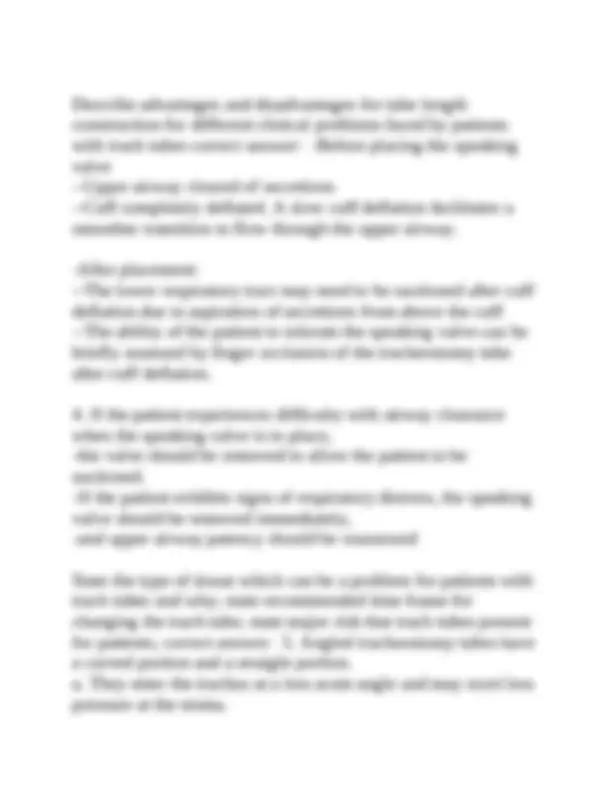
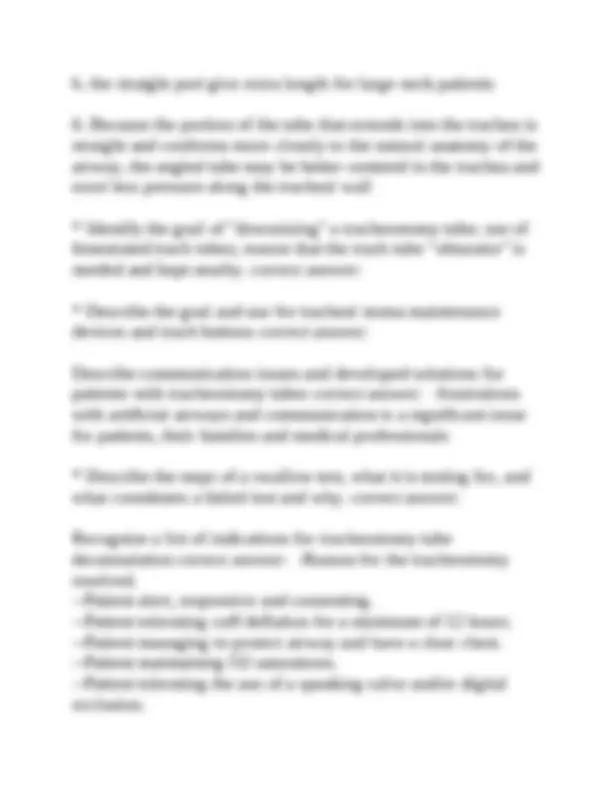
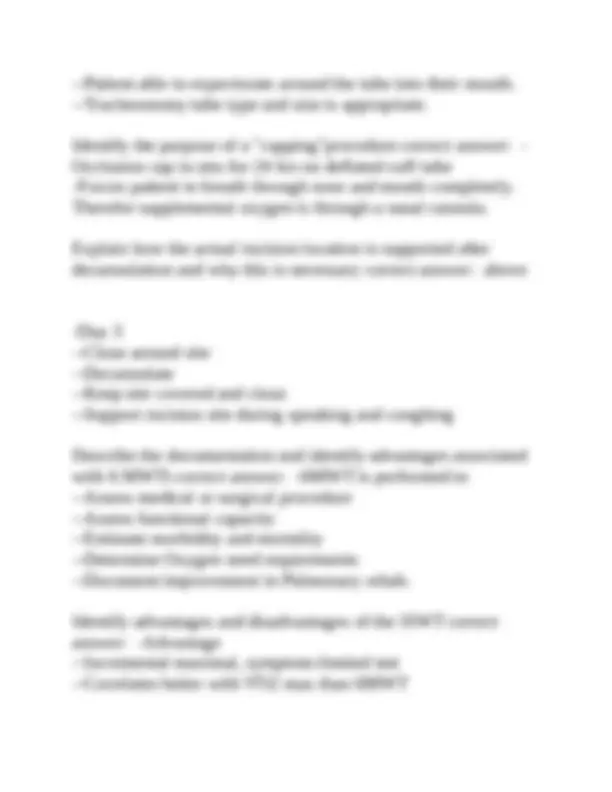
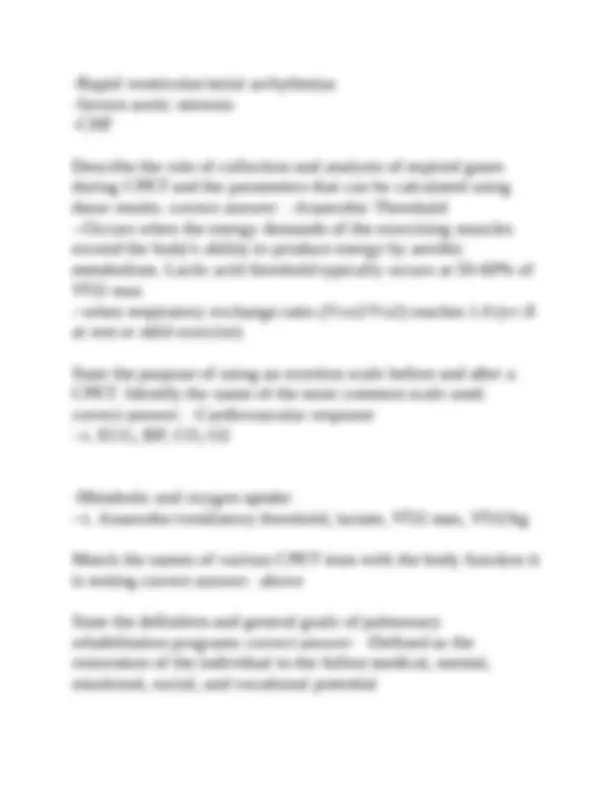
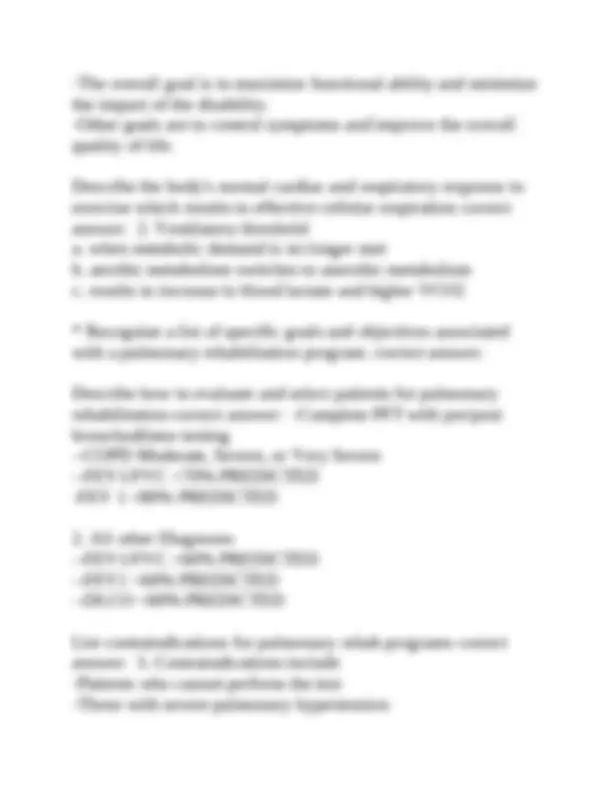
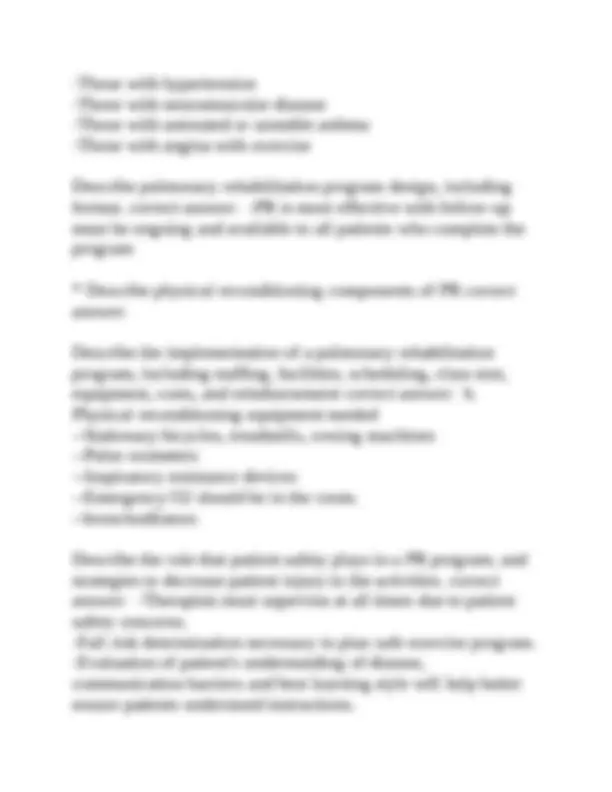


Study with the several resources on Docsity

Earn points by helping other students or get them with a premium plan


Prepare for your exams
Study with the several resources on Docsity

Earn points to download
Earn points by helping other students or get them with a premium plan
Community
Ask the community for help and clear up your study doubts
Discover the best universities in your country according to Docsity users
Free resources
Download our free guides on studying techniques, anxiety management strategies, and thesis advice from Docsity tutors
A comprehensive set of questions and answers related to respiratory therapy, focusing on topics such as ventilator weaning, tracheostomy management, end-of-life care, and cardiopulmonary exercise testing. It is a valuable resource for students and professionals in the field of respiratory care.
Typology: Exams
1 / 12

This page cannot be seen from the preview
Don't miss anything!







RES 204 Unit 3 exam Questions With Complete Solutions Describe the type of respiratory patients who typically stay at LTACHs and their LOS correct answer: Provide highly focused care to patients with complex medical conditions, including patients who have been ventilator dependent and difficult to wean a. they often have tracheostomy tube and not ETT Recognize a list of commonly encountered problems associated with ventilator weaning correct answer: 8. Difficulty with weaning/troubleshooting -Respiratory insufficiency -Airway Obstructions -Retention of Secretions -Blood in secretions -Patient anxiety Describe communication/equipment adjuncts that are used with trached and intubated patients correct answer:. Communication a. Boards allow patients to communicate by pointing to words and letters. b. Trach devices allow the patient to speak by directing air past vocal cords i. speaking valves, Passey Muir valve and fenestrated trachs Describe the techniques and issues associated with end-of-life situations for patients on mechanical ventilation correct answer: -Terminal wean for families who need extra time to make a decision.
-Process of removing ventilator support in stages like reducing FIO2, TV, etc. Identify the problems for RTs associated with a new tracheostomy for ventilator patients correct answer: Identify issues associated with trach tube diameters, lengths and angles correct answer: -Extreme care must be taken to manage a new tracheostomy site. -Gentle cleaning -Guard it from --accidental decannulation --excessive movement (stabilize vent connection)
b. the straight port give extra length for large neck patients
--Patient able to expectorate around the tube into their mouth. --Tracheostomy tube type and size is appropriate. Identify the purpose of a "capping"procedure correct answer: - Occlusion cap in situ for 24 hrs on deflated cuff tube -Forces patient to breath through nose and mouth completely. Therefor supplemental oxygen is through a nasal cannula. Explain how the actual incision location is supported after decannulation and why this is necessary correct answer: above -Day 3 --Clean around site --Decannulate --Keep site covered and clean --Support incision site during speaking and coughing Describe the documentation and identify advantages associated with 6 MWTt correct answer: -6MWT is performed to --Assess medical or surgical procedure --Assess functional capacity --Estimate morbidity and mortality --Determine Oxygen need requirements --Document improvement in Pulmonary rehab. Identify advantages and disadvantages of the ISWT correct answer: -Advantage --Incremental maximal, symptom-limited test --Correlates better with V̊O2 max than 6MWT
Recognize a list of CPET variables and their uses from basic to advanced correct answer: Describe end-points associated with maximal exercise capability and indications for terminating CPET correct answer: -Cardiac arrhythmias --2mm horizontal or down-sloping ST depression or elevation --T-wave inversion or Q waves --V-tach --Sustained supraventricular tachycardia (SVT) --Increasing frequency of multifocal PVC's --Development of 2nd or 3rd degree heart block --Exercise-induced L or R bundle branch block -Other Indications --Progressive chest pain --Sweating and pallor --Systolic pressure > 250mmHg --Diastolic pressure > 120mmHg --Failure of systolic pressure to h or a i of 10mmHg with h workload --Lightheadedness, mental confusion, or headache --Cyanosis --Nausea or vomiting --Muscle cramping Identify contraindications to CPET correct answer: -Recent MI (within 4 wks) -Unstable angina -2nd or 3rd degree heart block
-Rapid ventricular/atrial arrhythmias -Severe aortic stenosis -CHF Describe the role of collection and analysis of expired gases during CPET and the parameters that can be calculated using these results. correct answer: -Anaerobic Threshold --Occurs when the energy demands of the exercising muscles exceed the body's ability to produce energy by aerobic metabolism. Lactic acid threshold typically occurs at 50-60% of V̊O2 max --when respiratory exchange ratio (Vco2/Vo2) reaches 1.0 (n=. at rest or mild exercise) State the purpose of using an exertion scale before and after a CPET. Identify the name of the most common scale used. correct answer: -Cardiovascular response --i. ECG, BP, CO, O -Metabolic and oxygen uptake --i. Anaerobic/ventilatory threshold, lactate, V̊O2 max, V̊O2/kg Match the names of various CPET tests with the body function it is testing correct answer: above State the definition and general goals of pulmonary rehabilitation programs correct answer: -Defined as the restoration of the individual to the fullest medical, mental, emotional, social, and vocational potential
-Those with hypertension -Those with neuromuscular disease -Those with untreated or unstable asthma -Those with angina with exercise Describe pulmonary rehabilitation program design, including format. correct answer: -PR is most effective with follow-up must be ongoing and available to all patients who complete the program
d) Monitor blood pressure and oxygen saturation during exercise List 3 requirements for a patient to be eligible for a PR program including PFT results. correct answer: A. Entry into Pulmonary Rehabilitation -Referral from physician (signed & dated) -Qualifying PFT (within past 12 months) -Proper diagnosis as identified in ICD9 coding (DRG) Recognize a list of activities and information covered in the first and second visit of a new patient in PR program. correct answer: -Before and after --HR RR SaO2 FIO2 BP --iv. total distance walked --v. total rest periods needed --vi. Therapist can then establish first exercise prescription --vii. Give O2 if SpO2 >88% Recognize a list of patient assessment boundaries that are measured during an exercise session and which can lead to early termination of the session. correct answer: -Maximum HR determined by the Karvonen Scale (220-age-resting HR x .6 + resting HR= Maximum HR). -Resting HR less than 120 bpm. -Blood Pressure at rest not to exceed 180/ -Blood Pressure with exercise not to exceed 220/110 unless specified by physician. -If Diabetic - glucose above normal level at least 70 mg/dl Identify the potential hazards associated with pulmonary rehabilitation correct answer: above